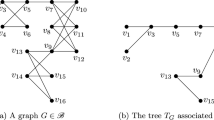Abstract
Based on difference sequence and Hoey sequence, three types of (2, F) and (3, F) quasi cyclic (QC) low-density parity-check (LDPC) codes are constructed. All 4-cycles and even 6-cycles are removed in the Tanner graph, and the girth is not less than six. The decoding complexity as well as extension to irregular case is analyzed. Simulation results show that in AWGN and Rayleigh fading channels, the codes can achieve the same error performance as their counterpart PEG codes, and outperform the corresponding MacKay codes and array codes.
Similar content being viewed by others
References
Gallager R G. Low density parity-check codes. IRE Trans Inf Theory, 1962, 8: 21–28
MacKay D J C. Good error correcting codes based on very sparse matrices. IEEE Trans Inf Theory, 1999, 45: 399–431
Richardson T J, Urbanke R L. The capacity of low-density parity-check codes under message-passing decoding. IEEE Trans Inf Theory, 2001, 47: 599–618
Lin C Y, Chou S C, Ku M K. Operation reduced low-density parity-check decoding algorithms for low power communication systems. Int J Commun Syst, 2013, 26: 68–83
Huang J, Zhang L J. Relative-residual-based dynamic schedule for belief propagation decoding of LDPC codes. China Commun, 2011, 8: 47–53
Liu M H, Zhang L J. Iterative hybrid decoding algorithm for LDPC codes based on attenuation factor. Front Electr Electron Eng, 2012, 7: 279–285
Huang J F, Huang C M, Yang C C. Construction of one-coincidence sequence quasi-cyclic LDPC codes of large girth. IEEE Trans Inf Theory, 2012, 58: 1825–1836
Zhang L, Huang Q, Lin S, et al. Quasi-cyclic LDPC codes: an algebraic construction, rank analysis, and codes on Latin squares. IEEE Trans Commun, 2010, 58: 3126–3139
Falsafain H, Esmaeili M. A new construction of structured binary regular LDPC codes based on Steiner systems with parameter t > 2. IEEE Trans Commun, 2012, 60: 74–80
Wang K Y, Xiao Y, Kim K. Construction of protograph LDPC codes with circular generator matrices. J Syst Eng Electron, 2011, 22: 840–847
Kang J Y, Huang Q, Zhang L, et al. Quasi-cyclic LDPC codes: an algebraic construction. IEEE Trans Commun, 2010, 58: 1383–1396
Nguyen D V, Chilappagari S K, Marcellin M W, et al. On the construction of structured LDPC codes free of small trapping sets. IEEE Trans Inf Theory, 2012, 58: 2280–2302
Myung S, Yang K, Kim J. Quasi-cyclic LDPC codes for fast encoding. IEEE Trans Inf Theory, 2005, 51: 2894–2901
Chen L, Djurdjevic I, Xu J. Construction of QC LDPC codes based on the minimum-weight codewords of RS codes. In: Proceedings of IEEE International Symposium on Information Theory, Chicago, 2004. 239
Lan L, Zeng L Q, Tai Y Y, et al. Construction of quasi-cyclic LDPC codes for AWGN and binary erasure channels: a finite field approach. IEEE Trans Inf Theory, 2007, 53: 2429–2458
Fossorier M P C. Quasi-cyclic low-density parity-check codes from circulant permutation matrices. IEEE Trans Inf Theory, 2004, 50: 1788–1794
Fan J L. Array codes as low-density parity-check codes. In: Proceedings of 2nd International Symposium on Turbo Codes, Brest, 2000. 553–556
Kim J L, Peled U N, Perepelitsa I, et al. Explicit construction of families of LDPC codes with no 4-cycles. IEEE Trans Inf Theory, 2004, 50: 2378–2388
Tanner R M, Sridhara D, Sridharan A, et al. LDPC block and convolutional codes based on circulant matrices. IEEE Trans Inf Theory, 2004, 50: 2966–2984
Song H, Liu J, Kumar B. Low complexity LDPC codes for partial response channels. In: Proceedings of IEEE Globecom Conference, Taipei, 2002. 1294–1299
Tanner R M. A recursive approach to low complexity codes. IEEE Trans Inf Theory, 1981, 27: 533–547
Brualdi R A. Introductory Combinatorics. 3rd ed. New Jersey: Prentice Hall, 1999
Hu X Y, Eleftheriou E, Arnold D M. Progressive edge-growth Tanner graphs. In: Proceedings of IEEE Globecom Conference, San Antonio, 2001. 995–1001
Eleftheriou E, Ölcer S. Low-density parity-check codes for digital subscriber lines. In: Proceedings of IEEE International Conference on Communications, New York, 2002. 1752–1757
Varnica N, Kavcic A. Optimized low-density parity-check codes for partial response channels. IEEE Comm Lett, 2003, 7: 168–170
Thangaraj A, McLaughlin S W. Thresholds and scheduling for LDPC-coded partial response channels. IEEE Trans Magnet, 2002, 38: 2307–2309
Ge X, Xia S T. Structured non-binary LDPC codes with large girth. IET Electron Lett, 2007, 43: 1220–1222
Peng F, Ryan W E, Wesel R D. Surrogate-channel design of universal LDPC codes. IEEE Comm Lett, 2006, 10: 480–482
Jones C R, Tian T, Villasenor J, et al. The universal operation of LDPC codes over scalar fading channels. IEEE Trans Comm, 2007, 55: 122–132
Hou J, Siegel P, Milstein L B. Performance analysis and code optimization of low density parity-check codes on Rayleigh fading channels. IEEE J Select Area Comm, 2001, 19: 924–934
Xu J, Chen L, Djurdjevic I, et al. Construction of regular and irregular LDPC codes: geometry decomposition and masking. IEEE Trans Inf Theory, 2007, 53: 121–134
Richardson T J, Urbanke R A, Urbanke R L. Design of capacity-approaching irregular LDPC codes. IEEE Trans Inf Theory, 2001, 47: 619–637
Author information
Authors and Affiliations
Corresponding author
Rights and permissions
About this article
Cite this article
Zhang, L., Li, B. & Cheng, L. Constructions of QC LDPC codes based on integer sequences. Sci. China Inf. Sci. 57, 1–14 (2014). https://doi.org/10.1007/s11432-013-4971-x
Received:
Accepted:
Published:
Issue Date:
DOI: https://doi.org/10.1007/s11432-013-4971-x




